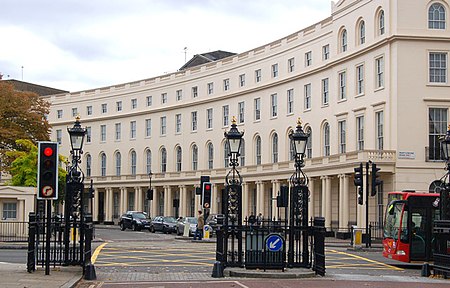Park Crescent, London

Park Crescent is at the north end of Portland Place and south of Marylebone Road in London. The crescent consists of elegant stuccoed terraced houses by the architect John Nash, which form a semicircle. The crescent is part of Nash's and wider town-planning visions of Roman-inspired imperial West End approaches to Regent's Park. It was originally conceived as a circus (circle) to be named Regent's Circus but instead Park Square was built to the north. The only buildings on the Regent's Park side of the square are small garden buildings, enabling higher floors of the Park Crescent buildings to have a longer, green northern view. It was built under the patronage of the Prince Regent. As the freeholder, the Crown Estate co-organises repairs, maintains the gardens and has a minor, overarching interest, entitled to lease renewal premiums and any agreed ground rents.Both terraces and the communal garden have statutory protection in the highest, rarest categories. This is Grade I listed status: on the National Heritage List for England and on the Register of Historic Parks and Gardens (as part of Regent's Park).
Excerpt from the Wikipedia article Park Crescent, London (License: CC BY-SA 3.0, Authors, Images).Park Crescent, London
Park Crescent, City of Westminster Fitzrovia
Geographical coordinates (GPS) Address Nearby Places Show on map
Geographical coordinates (GPS)
| Latitude | Longitude |
|---|---|
| N 51.5229 ° | E -0.1462 ° |
Address
Park Crescent
Park Crescent
W1B 1LT City of Westminster, Fitzrovia
England, United Kingdom
Open on Google Maps









